Organisational Behaviour: Theories, Problems, Critical Evaluation
VerifiedAdded on 2019/09/20
|8
|2340
|216
Essay
AI Summary
This essay delves into the multifaceted realm of organisational behaviour, commencing with an exploration of foundational theories, notably Max Weber's theory of management and the Systems Theory, which provide a framework for understanding organisational structures and dynamics. The essay then transitions to address prevalent organisational problems such as poor productivity, conflicts among employees, and communication breakdowns, offering insights into their causes and potential solutions. It emphasizes the significance of leadership in fostering a positive work environment, promoting effective communication, and managing cultural diversity. The critical evaluation section assesses the relevance of these theories and concepts in the current globalized and technologically advanced environment, examining how modern workplace practices have evolved and adapted to these changes. The essay underscores the importance of adaptability, ethical considerations, and the continuous evolution of organisational strategies to ensure sustained success.
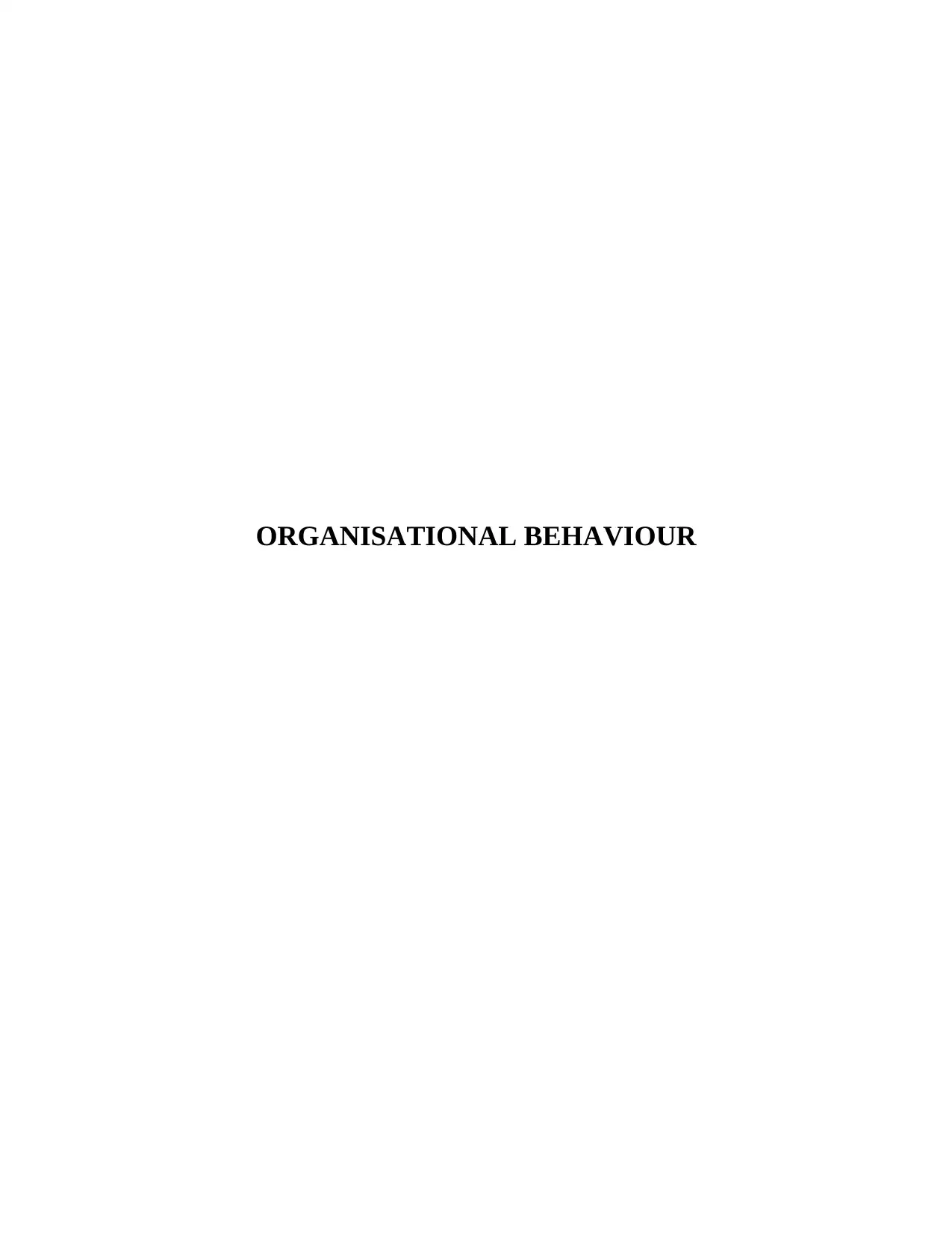
ORGANISATIONAL BEHAVIOUR
Paraphrase This Document
Need a fresh take? Get an instant paraphrase of this document with our AI Paraphraser
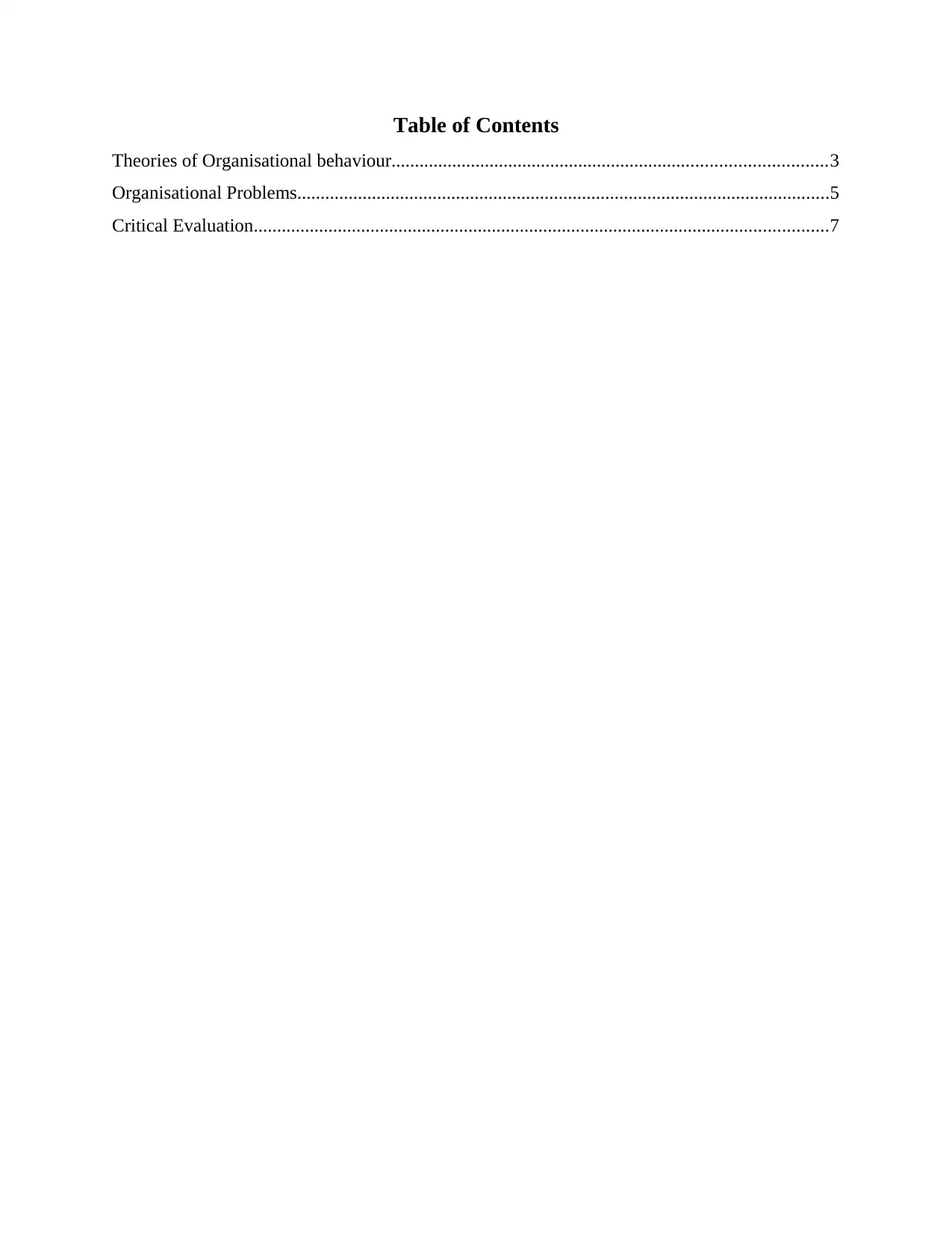
Table of Contents
Theories of Organisational behaviour.............................................................................................3
Organisational Problems..................................................................................................................5
Critical Evaluation...........................................................................................................................7
Theories of Organisational behaviour.............................................................................................3
Organisational Problems..................................................................................................................5
Critical Evaluation...........................................................................................................................7
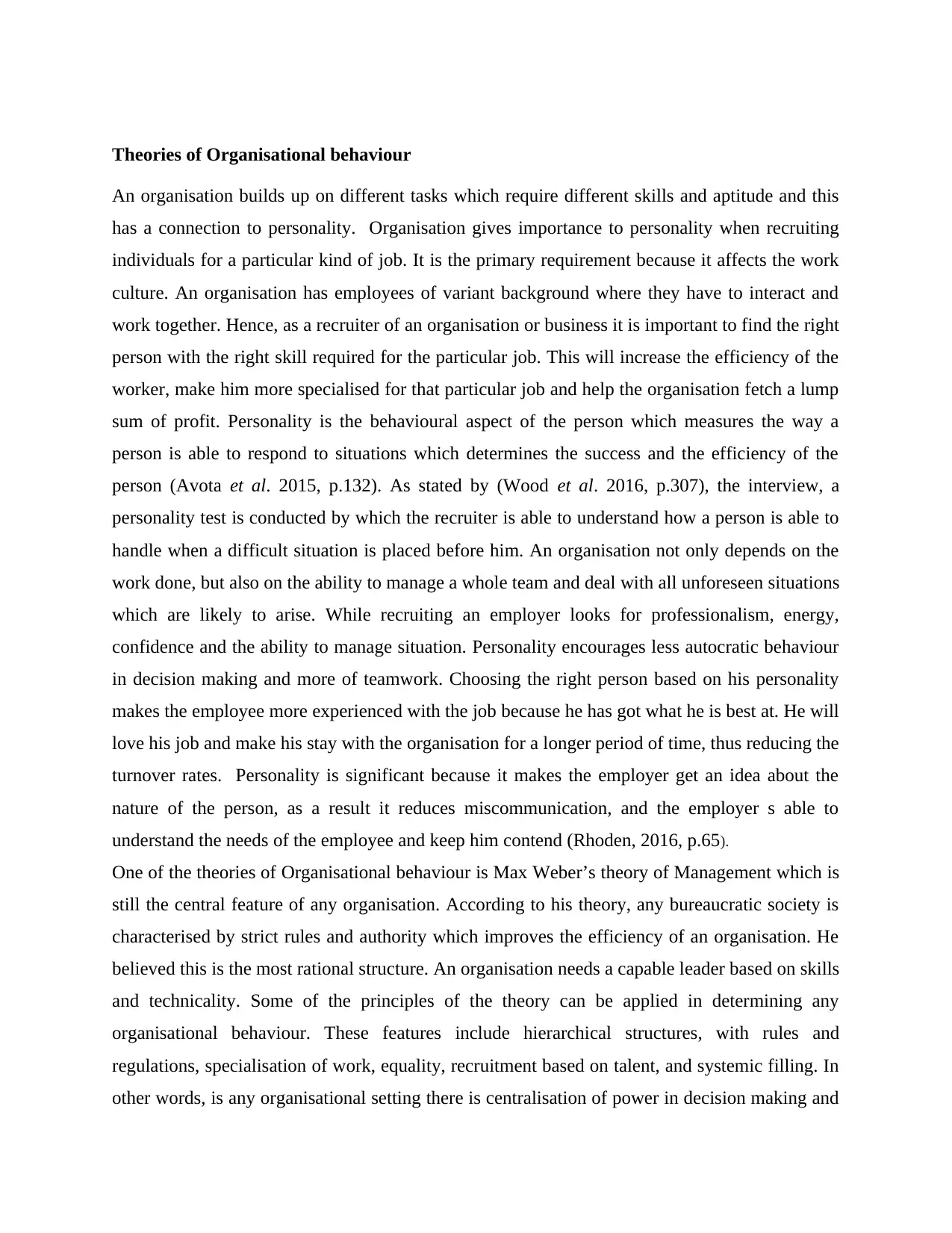
Theories of Organisational behaviour
An organisation builds up on different tasks which require different skills and aptitude and this
has a connection to personality. Organisation gives importance to personality when recruiting
individuals for a particular kind of job. It is the primary requirement because it affects the work
culture. An organisation has employees of variant background where they have to interact and
work together. Hence, as a recruiter of an organisation or business it is important to find the right
person with the right skill required for the particular job. This will increase the efficiency of the
worker, make him more specialised for that particular job and help the organisation fetch a lump
sum of profit. Personality is the behavioural aspect of the person which measures the way a
person is able to respond to situations which determines the success and the efficiency of the
person (Avota et al. 2015, p.132). As stated by (Wood et al. 2016, p.307), the interview, a
personality test is conducted by which the recruiter is able to understand how a person is able to
handle when a difficult situation is placed before him. An organisation not only depends on the
work done, but also on the ability to manage a whole team and deal with all unforeseen situations
which are likely to arise. While recruiting an employer looks for professionalism, energy,
confidence and the ability to manage situation. Personality encourages less autocratic behaviour
in decision making and more of teamwork. Choosing the right person based on his personality
makes the employee more experienced with the job because he has got what he is best at. He will
love his job and make his stay with the organisation for a longer period of time, thus reducing the
turnover rates. Personality is significant because it makes the employer get an idea about the
nature of the person, as a result it reduces miscommunication, and the employer s able to
understand the needs of the employee and keep him contend (Rhoden, 2016, p.65).
One of the theories of Organisational behaviour is Max Weber’s theory of Management which is
still the central feature of any organisation. According to his theory, any bureaucratic society is
characterised by strict rules and authority which improves the efficiency of an organisation. He
believed this is the most rational structure. An organisation needs a capable leader based on skills
and technicality. Some of the principles of the theory can be applied in determining any
organisational behaviour. These features include hierarchical structures, with rules and
regulations, specialisation of work, equality, recruitment based on talent, and systemic filling. In
other words, is any organisational setting there is centralisation of power in decision making and
An organisation builds up on different tasks which require different skills and aptitude and this
has a connection to personality. Organisation gives importance to personality when recruiting
individuals for a particular kind of job. It is the primary requirement because it affects the work
culture. An organisation has employees of variant background where they have to interact and
work together. Hence, as a recruiter of an organisation or business it is important to find the right
person with the right skill required for the particular job. This will increase the efficiency of the
worker, make him more specialised for that particular job and help the organisation fetch a lump
sum of profit. Personality is the behavioural aspect of the person which measures the way a
person is able to respond to situations which determines the success and the efficiency of the
person (Avota et al. 2015, p.132). As stated by (Wood et al. 2016, p.307), the interview, a
personality test is conducted by which the recruiter is able to understand how a person is able to
handle when a difficult situation is placed before him. An organisation not only depends on the
work done, but also on the ability to manage a whole team and deal with all unforeseen situations
which are likely to arise. While recruiting an employer looks for professionalism, energy,
confidence and the ability to manage situation. Personality encourages less autocratic behaviour
in decision making and more of teamwork. Choosing the right person based on his personality
makes the employee more experienced with the job because he has got what he is best at. He will
love his job and make his stay with the organisation for a longer period of time, thus reducing the
turnover rates. Personality is significant because it makes the employer get an idea about the
nature of the person, as a result it reduces miscommunication, and the employer s able to
understand the needs of the employee and keep him contend (Rhoden, 2016, p.65).
One of the theories of Organisational behaviour is Max Weber’s theory of Management which is
still the central feature of any organisation. According to his theory, any bureaucratic society is
characterised by strict rules and authority which improves the efficiency of an organisation. He
believed this is the most rational structure. An organisation needs a capable leader based on skills
and technicality. Some of the principles of the theory can be applied in determining any
organisational behaviour. These features include hierarchical structures, with rules and
regulations, specialisation of work, equality, recruitment based on talent, and systemic filling. In
other words, is any organisational setting there is centralisation of power in decision making and
⊘ This is a preview!⊘
Do you want full access?
Subscribe today to unlock all pages.

Trusted by 1+ million students worldwide
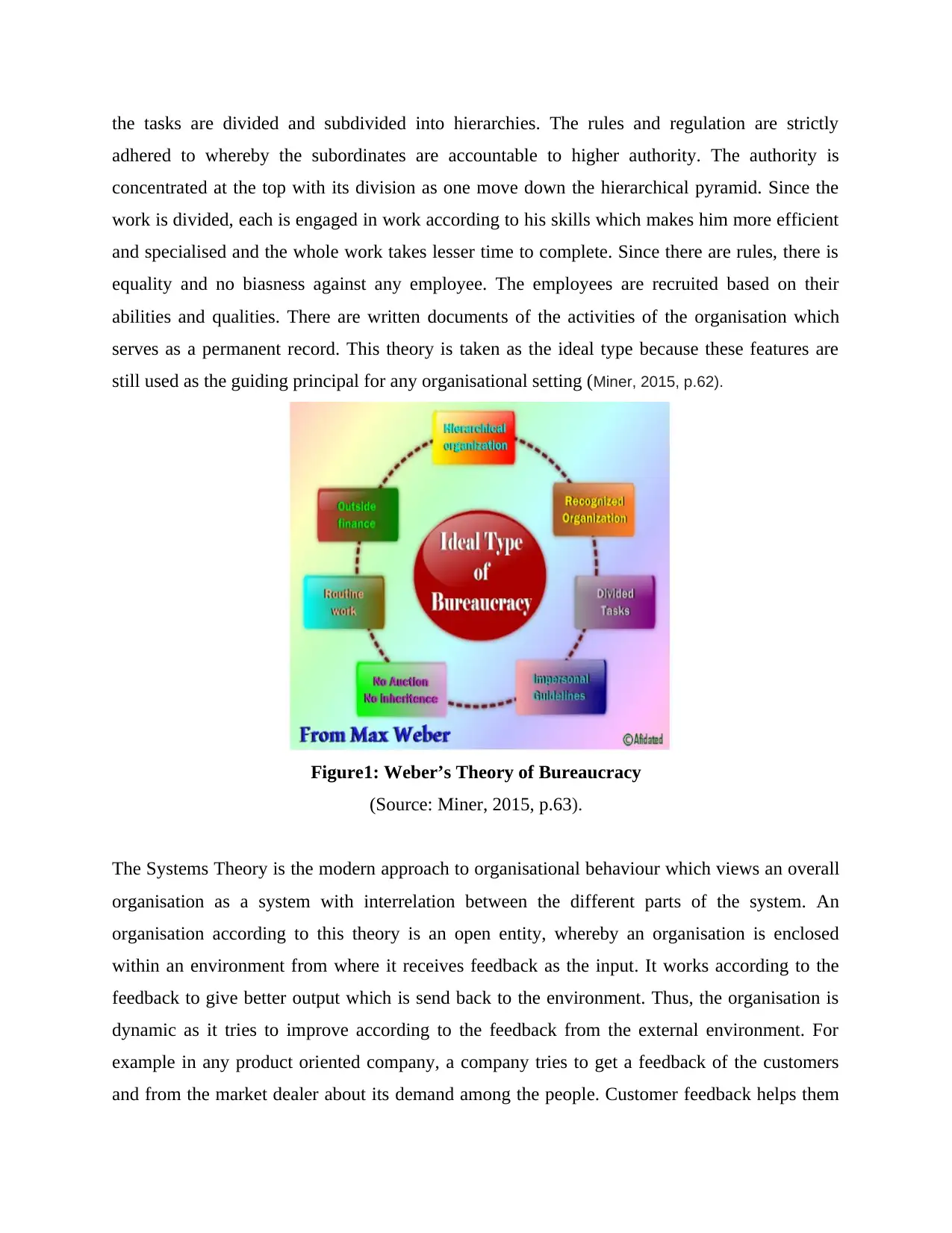
the tasks are divided and subdivided into hierarchies. The rules and regulation are strictly
adhered to whereby the subordinates are accountable to higher authority. The authority is
concentrated at the top with its division as one move down the hierarchical pyramid. Since the
work is divided, each is engaged in work according to his skills which makes him more efficient
and specialised and the whole work takes lesser time to complete. Since there are rules, there is
equality and no biasness against any employee. The employees are recruited based on their
abilities and qualities. There are written documents of the activities of the organisation which
serves as a permanent record. This theory is taken as the ideal type because these features are
still used as the guiding principal for any organisational setting (Miner, 2015, p.62).
Figure1: Weber’s Theory of Bureaucracy
(Source: Miner, 2015, p.63).
The Systems Theory is the modern approach to organisational behaviour which views an overall
organisation as a system with interrelation between the different parts of the system. An
organisation according to this theory is an open entity, whereby an organisation is enclosed
within an environment from where it receives feedback as the input. It works according to the
feedback to give better output which is send back to the environment. Thus, the organisation is
dynamic as it tries to improve according to the feedback from the external environment. For
example in any product oriented company, a company tries to get a feedback of the customers
and from the market dealer about its demand among the people. Customer feedback helps them
adhered to whereby the subordinates are accountable to higher authority. The authority is
concentrated at the top with its division as one move down the hierarchical pyramid. Since the
work is divided, each is engaged in work according to his skills which makes him more efficient
and specialised and the whole work takes lesser time to complete. Since there are rules, there is
equality and no biasness against any employee. The employees are recruited based on their
abilities and qualities. There are written documents of the activities of the organisation which
serves as a permanent record. This theory is taken as the ideal type because these features are
still used as the guiding principal for any organisational setting (Miner, 2015, p.62).
Figure1: Weber’s Theory of Bureaucracy
(Source: Miner, 2015, p.63).
The Systems Theory is the modern approach to organisational behaviour which views an overall
organisation as a system with interrelation between the different parts of the system. An
organisation according to this theory is an open entity, whereby an organisation is enclosed
within an environment from where it receives feedback as the input. It works according to the
feedback to give better output which is send back to the environment. Thus, the organisation is
dynamic as it tries to improve according to the feedback from the external environment. For
example in any product oriented company, a company tries to get a feedback of the customers
and from the market dealer about its demand among the people. Customer feedback helps them
Paraphrase This Document
Need a fresh take? Get an instant paraphrase of this document with our AI Paraphraser
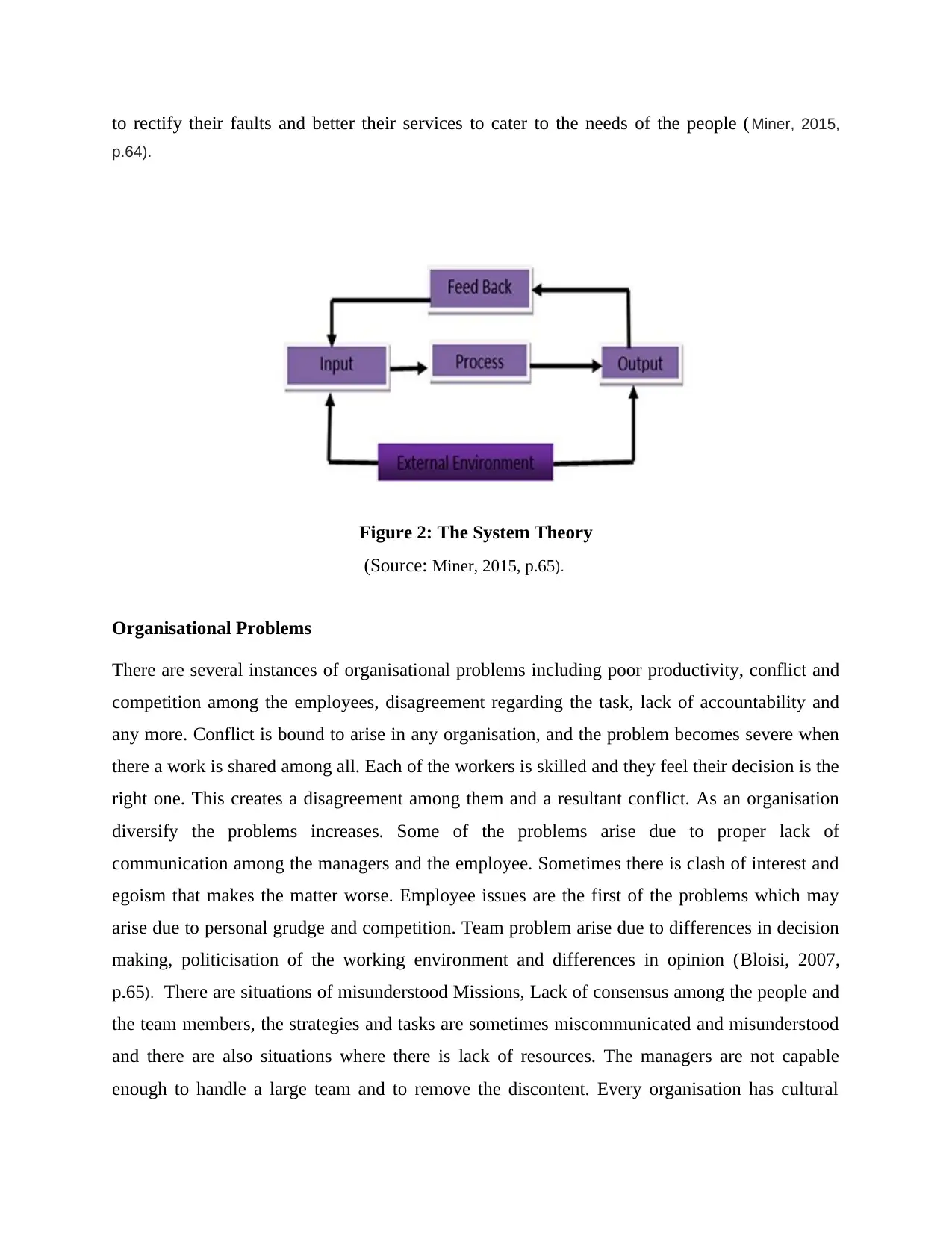
to rectify their faults and better their services to cater to the needs of the people (Miner, 2015,
p.64).
Figure 2: The System Theory
(Source: Miner, 2015, p.65).
Organisational Problems
There are several instances of organisational problems including poor productivity, conflict and
competition among the employees, disagreement regarding the task, lack of accountability and
any more. Conflict is bound to arise in any organisation, and the problem becomes severe when
there a work is shared among all. Each of the workers is skilled and they feel their decision is the
right one. This creates a disagreement among them and a resultant conflict. As an organisation
diversify the problems increases. Some of the problems arise due to proper lack of
communication among the managers and the employee. Sometimes there is clash of interest and
egoism that makes the matter worse. Employee issues are the first of the problems which may
arise due to personal grudge and competition. Team problem arise due to differences in decision
making, politicisation of the working environment and differences in opinion (Bloisi, 2007,
p.65). There are situations of misunderstood Missions, Lack of consensus among the people and
the team members, the strategies and tasks are sometimes miscommunicated and misunderstood
and there are also situations where there is lack of resources. The managers are not capable
enough to handle a large team and to remove the discontent. Every organisation has cultural
p.64).
Figure 2: The System Theory
(Source: Miner, 2015, p.65).
Organisational Problems
There are several instances of organisational problems including poor productivity, conflict and
competition among the employees, disagreement regarding the task, lack of accountability and
any more. Conflict is bound to arise in any organisation, and the problem becomes severe when
there a work is shared among all. Each of the workers is skilled and they feel their decision is the
right one. This creates a disagreement among them and a resultant conflict. As an organisation
diversify the problems increases. Some of the problems arise due to proper lack of
communication among the managers and the employee. Sometimes there is clash of interest and
egoism that makes the matter worse. Employee issues are the first of the problems which may
arise due to personal grudge and competition. Team problem arise due to differences in decision
making, politicisation of the working environment and differences in opinion (Bloisi, 2007,
p.65). There are situations of misunderstood Missions, Lack of consensus among the people and
the team members, the strategies and tasks are sometimes miscommunicated and misunderstood
and there are also situations where there is lack of resources. The managers are not capable
enough to handle a large team and to remove the discontent. Every organisation has cultural
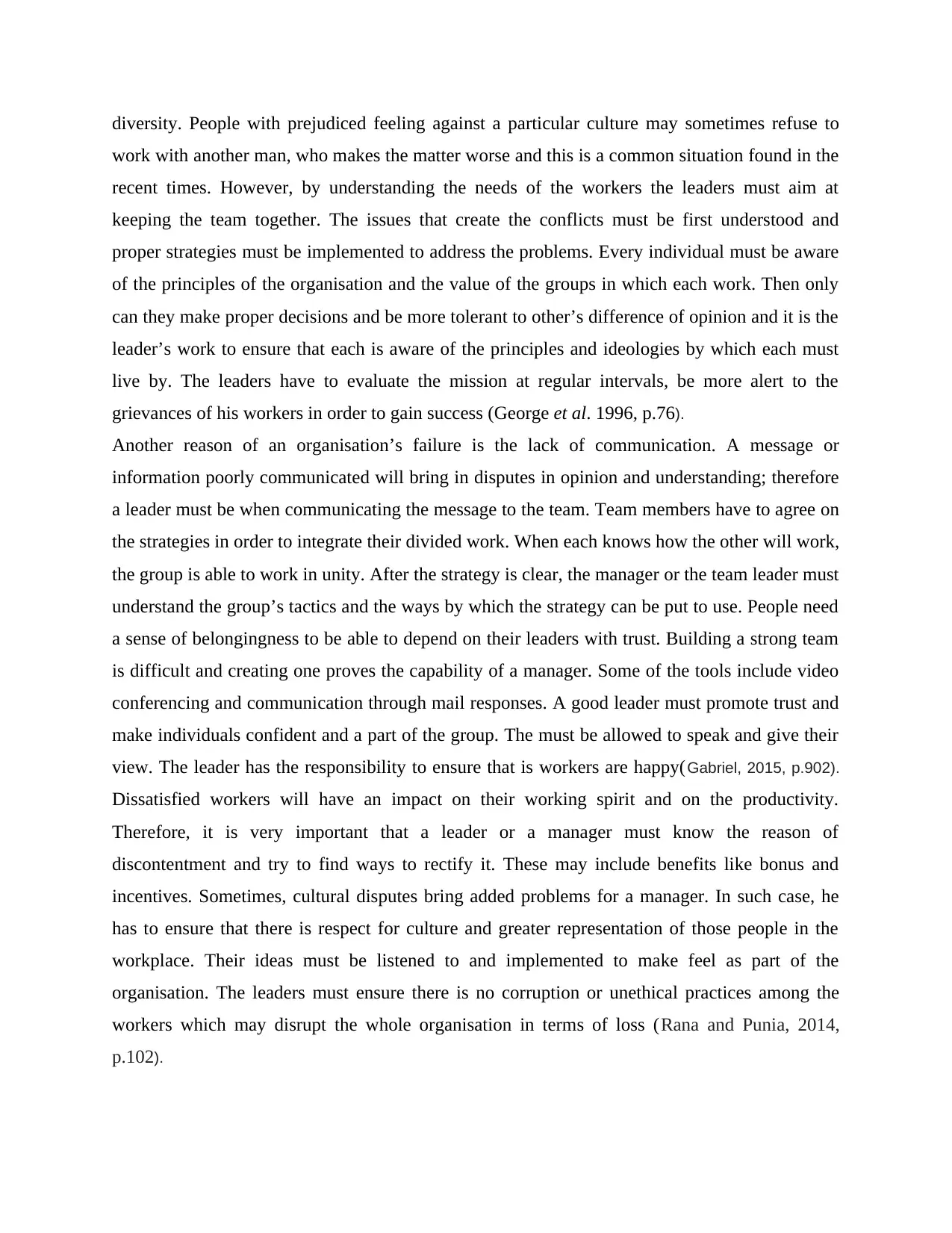
diversity. People with prejudiced feeling against a particular culture may sometimes refuse to
work with another man, who makes the matter worse and this is a common situation found in the
recent times. However, by understanding the needs of the workers the leaders must aim at
keeping the team together. The issues that create the conflicts must be first understood and
proper strategies must be implemented to address the problems. Every individual must be aware
of the principles of the organisation and the value of the groups in which each work. Then only
can they make proper decisions and be more tolerant to other’s difference of opinion and it is the
leader’s work to ensure that each is aware of the principles and ideologies by which each must
live by. The leaders have to evaluate the mission at regular intervals, be more alert to the
grievances of his workers in order to gain success (George et al. 1996, p.76).
Another reason of an organisation’s failure is the lack of communication. A message or
information poorly communicated will bring in disputes in opinion and understanding; therefore
a leader must be when communicating the message to the team. Team members have to agree on
the strategies in order to integrate their divided work. When each knows how the other will work,
the group is able to work in unity. After the strategy is clear, the manager or the team leader must
understand the group’s tactics and the ways by which the strategy can be put to use. People need
a sense of belongingness to be able to depend on their leaders with trust. Building a strong team
is difficult and creating one proves the capability of a manager. Some of the tools include video
conferencing and communication through mail responses. A good leader must promote trust and
make individuals confident and a part of the group. The must be allowed to speak and give their
view. The leader has the responsibility to ensure that is workers are happy(Gabriel, 2015, p.902).
Dissatisfied workers will have an impact on their working spirit and on the productivity.
Therefore, it is very important that a leader or a manager must know the reason of
discontentment and try to find ways to rectify it. These may include benefits like bonus and
incentives. Sometimes, cultural disputes bring added problems for a manager. In such case, he
has to ensure that there is respect for culture and greater representation of those people in the
workplace. Their ideas must be listened to and implemented to make feel as part of the
organisation. The leaders must ensure there is no corruption or unethical practices among the
workers which may disrupt the whole organisation in terms of loss (Rana and Punia, 2014,
p.102).
work with another man, who makes the matter worse and this is a common situation found in the
recent times. However, by understanding the needs of the workers the leaders must aim at
keeping the team together. The issues that create the conflicts must be first understood and
proper strategies must be implemented to address the problems. Every individual must be aware
of the principles of the organisation and the value of the groups in which each work. Then only
can they make proper decisions and be more tolerant to other’s difference of opinion and it is the
leader’s work to ensure that each is aware of the principles and ideologies by which each must
live by. The leaders have to evaluate the mission at regular intervals, be more alert to the
grievances of his workers in order to gain success (George et al. 1996, p.76).
Another reason of an organisation’s failure is the lack of communication. A message or
information poorly communicated will bring in disputes in opinion and understanding; therefore
a leader must be when communicating the message to the team. Team members have to agree on
the strategies in order to integrate their divided work. When each knows how the other will work,
the group is able to work in unity. After the strategy is clear, the manager or the team leader must
understand the group’s tactics and the ways by which the strategy can be put to use. People need
a sense of belongingness to be able to depend on their leaders with trust. Building a strong team
is difficult and creating one proves the capability of a manager. Some of the tools include video
conferencing and communication through mail responses. A good leader must promote trust and
make individuals confident and a part of the group. The must be allowed to speak and give their
view. The leader has the responsibility to ensure that is workers are happy(Gabriel, 2015, p.902).
Dissatisfied workers will have an impact on their working spirit and on the productivity.
Therefore, it is very important that a leader or a manager must know the reason of
discontentment and try to find ways to rectify it. These may include benefits like bonus and
incentives. Sometimes, cultural disputes bring added problems for a manager. In such case, he
has to ensure that there is respect for culture and greater representation of those people in the
workplace. Their ideas must be listened to and implemented to make feel as part of the
organisation. The leaders must ensure there is no corruption or unethical practices among the
workers which may disrupt the whole organisation in terms of loss (Rana and Punia, 2014,
p.102).
⊘ This is a preview!⊘
Do you want full access?
Subscribe today to unlock all pages.

Trusted by 1+ million students worldwide
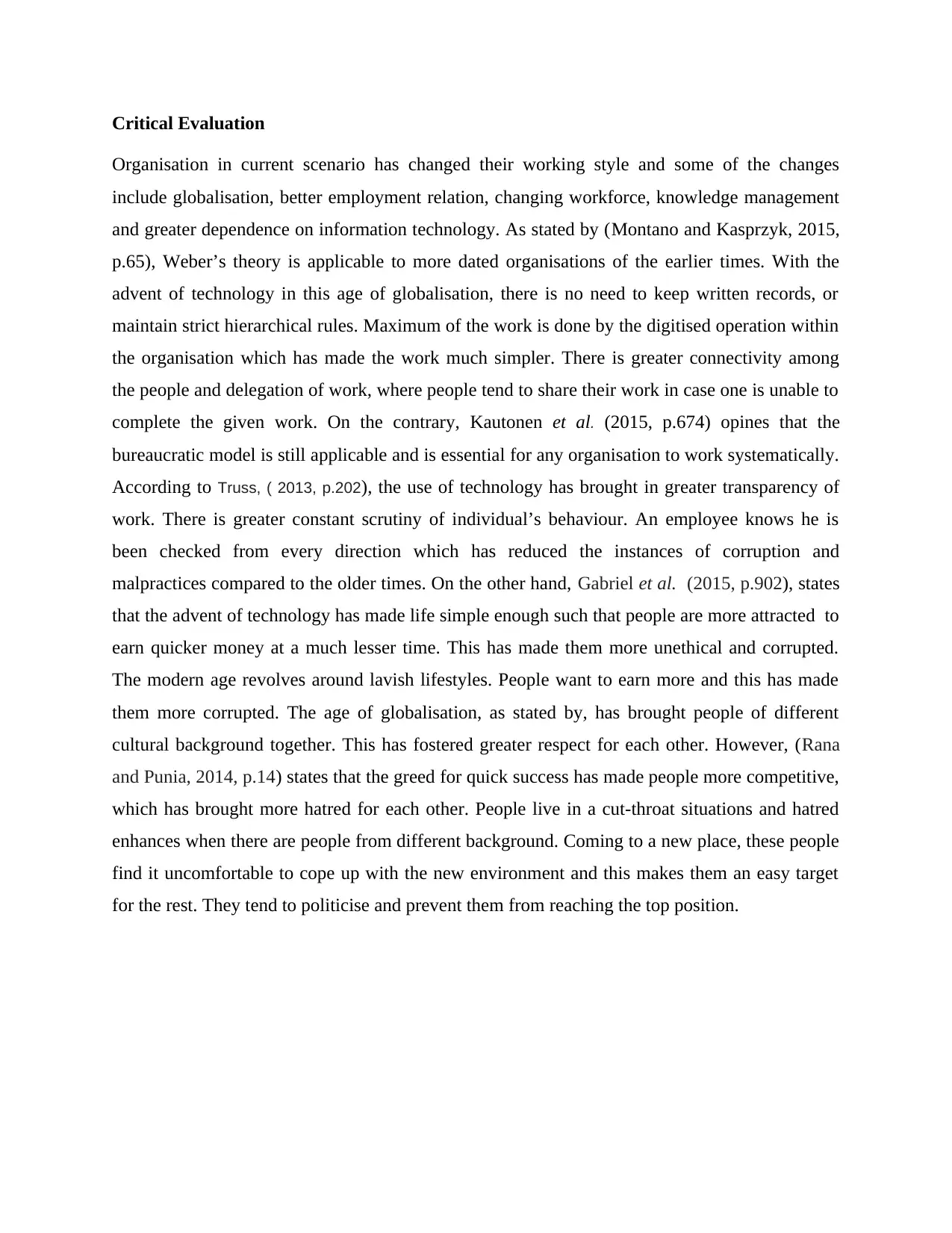
Critical Evaluation
Organisation in current scenario has changed their working style and some of the changes
include globalisation, better employment relation, changing workforce, knowledge management
and greater dependence on information technology. As stated by (Montano and Kasprzyk, 2015,
p.65), Weber’s theory is applicable to more dated organisations of the earlier times. With the
advent of technology in this age of globalisation, there is no need to keep written records, or
maintain strict hierarchical rules. Maximum of the work is done by the digitised operation within
the organisation which has made the work much simpler. There is greater connectivity among
the people and delegation of work, where people tend to share their work in case one is unable to
complete the given work. On the contrary, Kautonen et al. (2015, p.674) opines that the
bureaucratic model is still applicable and is essential for any organisation to work systematically.
According to Truss, ( 2013, p.202), the use of technology has brought in greater transparency of
work. There is greater constant scrutiny of individual’s behaviour. An employee knows he is
been checked from every direction which has reduced the instances of corruption and
malpractices compared to the older times. On the other hand, Gabriel et al. (2015, p.902), states
that the advent of technology has made life simple enough such that people are more attracted to
earn quicker money at a much lesser time. This has made them more unethical and corrupted.
The modern age revolves around lavish lifestyles. People want to earn more and this has made
them more corrupted. The age of globalisation, as stated by, has brought people of different
cultural background together. This has fostered greater respect for each other. However, (Rana
and Punia, 2014, p.14) states that the greed for quick success has made people more competitive,
which has brought more hatred for each other. People live in a cut-throat situations and hatred
enhances when there are people from different background. Coming to a new place, these people
find it uncomfortable to cope up with the new environment and this makes them an easy target
for the rest. They tend to politicise and prevent them from reaching the top position.
Organisation in current scenario has changed their working style and some of the changes
include globalisation, better employment relation, changing workforce, knowledge management
and greater dependence on information technology. As stated by (Montano and Kasprzyk, 2015,
p.65), Weber’s theory is applicable to more dated organisations of the earlier times. With the
advent of technology in this age of globalisation, there is no need to keep written records, or
maintain strict hierarchical rules. Maximum of the work is done by the digitised operation within
the organisation which has made the work much simpler. There is greater connectivity among
the people and delegation of work, where people tend to share their work in case one is unable to
complete the given work. On the contrary, Kautonen et al. (2015, p.674) opines that the
bureaucratic model is still applicable and is essential for any organisation to work systematically.
According to Truss, ( 2013, p.202), the use of technology has brought in greater transparency of
work. There is greater constant scrutiny of individual’s behaviour. An employee knows he is
been checked from every direction which has reduced the instances of corruption and
malpractices compared to the older times. On the other hand, Gabriel et al. (2015, p.902), states
that the advent of technology has made life simple enough such that people are more attracted to
earn quicker money at a much lesser time. This has made them more unethical and corrupted.
The modern age revolves around lavish lifestyles. People want to earn more and this has made
them more corrupted. The age of globalisation, as stated by, has brought people of different
cultural background together. This has fostered greater respect for each other. However, (Rana
and Punia, 2014, p.14) states that the greed for quick success has made people more competitive,
which has brought more hatred for each other. People live in a cut-throat situations and hatred
enhances when there are people from different background. Coming to a new place, these people
find it uncomfortable to cope up with the new environment and this makes them an easy target
for the rest. They tend to politicise and prevent them from reaching the top position.
Paraphrase This Document
Need a fresh take? Get an instant paraphrase of this document with our AI Paraphraser
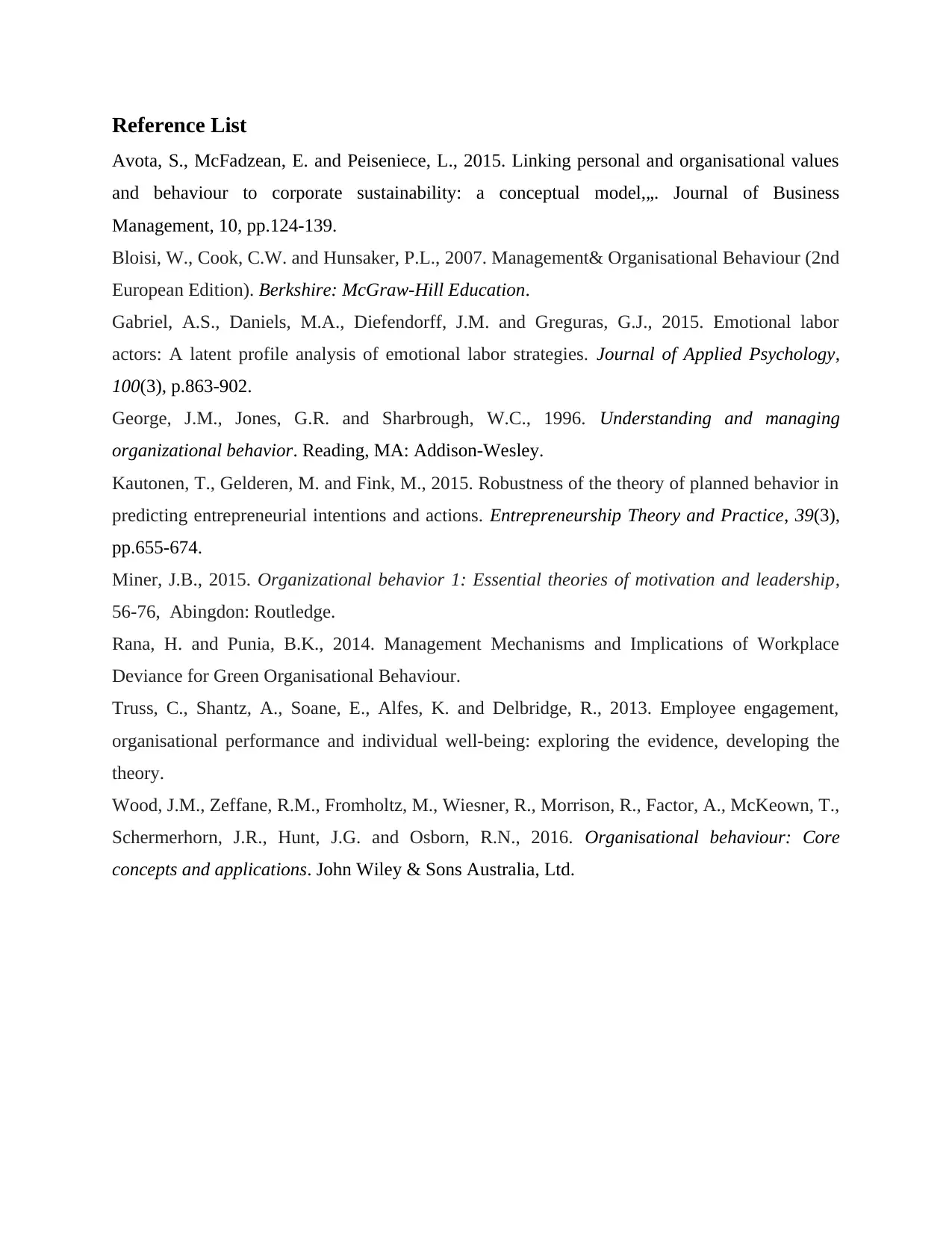
Reference List
Avota, S., McFadzean, E. and Peiseniece, L., 2015. Linking personal and organisational values
and behaviour to corporate sustainability: a conceptual model,„. Journal of Business
Management, 10, pp.124-139.
Bloisi, W., Cook, C.W. and Hunsaker, P.L., 2007. Management& Organisational Behaviour (2nd
European Edition). Berkshire: McGraw-Hill Education.
Gabriel, A.S., Daniels, M.A., Diefendorff, J.M. and Greguras, G.J., 2015. Emotional labor
actors: A latent profile analysis of emotional labor strategies. Journal of Applied Psychology,
100(3), p.863-902.
George, J.M., Jones, G.R. and Sharbrough, W.C., 1996. Understanding and managing
organizational behavior. Reading, MA: Addison-Wesley.
Kautonen, T., Gelderen, M. and Fink, M., 2015. Robustness of the theory of planned behavior in
predicting entrepreneurial intentions and actions. Entrepreneurship Theory and Practice, 39(3),
pp.655-674.
Miner, J.B., 2015. Organizational behavior 1: Essential theories of motivation and leadership,
56-76, Abingdon: Routledge.
Rana, H. and Punia, B.K., 2014. Management Mechanisms and Implications of Workplace
Deviance for Green Organisational Behaviour.
Truss, C., Shantz, A., Soane, E., Alfes, K. and Delbridge, R., 2013. Employee engagement,
organisational performance and individual well-being: exploring the evidence, developing the
theory.
Wood, J.M., Zeffane, R.M., Fromholtz, M., Wiesner, R., Morrison, R., Factor, A., McKeown, T.,
Schermerhorn, J.R., Hunt, J.G. and Osborn, R.N., 2016. Organisational behaviour: Core
concepts and applications. John Wiley & Sons Australia, Ltd.
Avota, S., McFadzean, E. and Peiseniece, L., 2015. Linking personal and organisational values
and behaviour to corporate sustainability: a conceptual model,„. Journal of Business
Management, 10, pp.124-139.
Bloisi, W., Cook, C.W. and Hunsaker, P.L., 2007. Management& Organisational Behaviour (2nd
European Edition). Berkshire: McGraw-Hill Education.
Gabriel, A.S., Daniels, M.A., Diefendorff, J.M. and Greguras, G.J., 2015. Emotional labor
actors: A latent profile analysis of emotional labor strategies. Journal of Applied Psychology,
100(3), p.863-902.
George, J.M., Jones, G.R. and Sharbrough, W.C., 1996. Understanding and managing
organizational behavior. Reading, MA: Addison-Wesley.
Kautonen, T., Gelderen, M. and Fink, M., 2015. Robustness of the theory of planned behavior in
predicting entrepreneurial intentions and actions. Entrepreneurship Theory and Practice, 39(3),
pp.655-674.
Miner, J.B., 2015. Organizational behavior 1: Essential theories of motivation and leadership,
56-76, Abingdon: Routledge.
Rana, H. and Punia, B.K., 2014. Management Mechanisms and Implications of Workplace
Deviance for Green Organisational Behaviour.
Truss, C., Shantz, A., Soane, E., Alfes, K. and Delbridge, R., 2013. Employee engagement,
organisational performance and individual well-being: exploring the evidence, developing the
theory.
Wood, J.M., Zeffane, R.M., Fromholtz, M., Wiesner, R., Morrison, R., Factor, A., McKeown, T.,
Schermerhorn, J.R., Hunt, J.G. and Osborn, R.N., 2016. Organisational behaviour: Core
concepts and applications. John Wiley & Sons Australia, Ltd.
1 out of 8
Related Documents
Your All-in-One AI-Powered Toolkit for Academic Success.
+13062052269
info@desklib.com
Available 24*7 on WhatsApp / Email
![[object Object]](/_next/static/media/star-bottom.7253800d.svg)
Unlock your academic potential
Copyright © 2020–2025 A2Z Services. All Rights Reserved. Developed and managed by ZUCOL.





